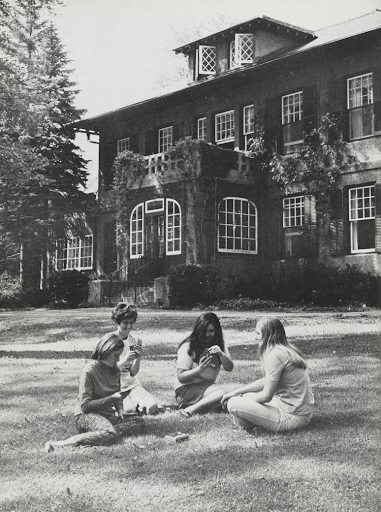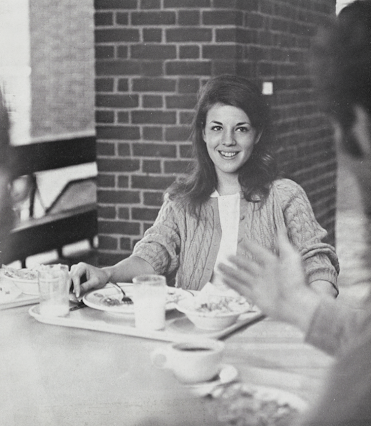A history of coeducation at the College
March 8, 2023

According to data published in April 2022, the College is composed of 2,129 undergraduate students, 1,098 of whom are women. But before 1971, this number was nearly zero.
The College only officially became a coeducational institution in the 1960s, though it allowed women to enroll in classes from time to time. The College officially opened its doors in 1793 with an undergraduate population of eighteen male students, but it would not confer a degree to a woman until Beatrice Wasserscheid graduated almost 140 years later. After petitioning the Board of Trustees, Wasserscheid was able to receive her master’s in American literature in 1931, becoming the first woman to earn a degree from the College. However, it was not until the 1960s that the College started to formally consider opening its doors to female students.
The College’s move toward coeducation commenced when then-President John Edward Sawyer ’39 determined that coeducation and Greek life could not coexist, he said in an oral interview with the Williams Alumni Review. Much of the College’s social structure, including intramural sports and student government, was built around Greek life, prompting the abolition of fraternities in 1962. Five years later, the administration established a Committee on Coordinate Education and Related Questions (CCERQ), otherwise known as Committee X, to study the effect of female students on the curriculum. The committee considered the possibility of forming a sister college of 650 women that would coordinate academically and socially with Williams.

At this time, the College accepted its first 30 female students from Vassar College for the spring semester in 1969. These admits stemmed from an exchange program in which the College sent 26 students to Vassar and accepted 30 students from the peer institution. That June, the trustees voted to admit women, opting for coeducation rather than a separate coordinate institution. In December, the first five women were accepted to the Class of 1971 as exchange junior students: Jane Gardner ’71, Ellen Josephson ’71, Judy Allerhand ’71, Gair Hemphill ’71, and Joan Hertzberger ’71 — who became her class’s valedictorian.
The same year, the College also accepted 40 other women as regular undergraduates into the sophomore and junior classes in order to ease the transition of the newly admitted female first-years. This decision came out around the same time as a March 1969 Record article polling student opinion on the admittance of women, with 81.5 percent in favor of coeducation and 14.5 percent opposed.
Motivations for coeducation
Around the country, the College’s peer institutions were also beginning to consider the possibility of integrating female students into their student bodies. In the Williams Alumni Review of 1968, the College reported that it was taking into account these national conversations when considering coeducation. “Since almost all small liberal arts colleges in our part of the country have been giving consideration to these same subjects, we have studied the reports and decisions of our friends and neighbors,” wrote John E. Lockwood, Class of 1925.
In 1969, Sawyer described what he saw as the educational benefits for admitting women to the College in a piece he published in the Williams Alumni Review. “The only real question is whether we could become an even better College and a more interesting community by the addition of coordinate education,” Sawyer wrote.
Outwardly, the College touted a number of such reasons for its shift to coeducation. However, underlying motives — such as the desire for financial benefits and a wider applicant pool — actually propelled the College’s seemingly altruistic and socially beneficial decision to admit women.
A Williams Alumni Review article from 1968 covered how the CCERQ found that under-enrolled departments would benefit from an influx of women who, the committee wrote, would be inclined toward different fields of study than men. Furthermore, administrators feared that, with the rise of coeducation around the country, male applicants would choose to attend a coeducational institution over the College.
Financial concerns further motivated the admittance of women to the College. According to Thomas Bleezarde, a former editor of the Williams Alumni Review, expanding departments to increase the student-faculty ratio would allow the College to cover the costs of hiring faculty. Nancy McIntire, the College’s first female dean, also said that one financial consideration was the fact that fewer women would be receiving financial aid.
Finally, the administration weighed the cultural shift that would result from integrating the sexes. While the loss of fraternities caused some discontent, the College concluded that women “would assist the break-down of the weekend partying and weekday studying trend” in a Williams Alumni Review article from 1969.
Experiences of first female students
Some of the first female students described their time at the College fondly. “The experience has been a very good one for all of us,” wrote Pacy White, a Vassar transfer, in a letter to College administration. The women often academically surpassed their male peers, and added “a new dimension to many previously all-male organizations,” she continued.
Nonetheless, there were both academic and social impediments to female students’ integration. Women said they felt socially ostracized and excluded, reporting instances of blatant sexism. One Record article explored how these women encountered students wearing t-shirts that read “Coeds go home” and described persistent criticism for the clothing that they wore. The classrooms, without female professors, proved to be difficult environments to navigate, while incorporation into extracurricular activities and clubs presented further difficulties.
The College’s cultural climate in 1969 added to the female students’ difficulties, epitomized by the front page of a September 1969 issue of the Record. One headline read “Telling It Like It Is: A Neophyte Needs To Know Where Willing Wenches Wait” — the article offered incoming first-years a “handy guide to the fair sex in New England,” detailing and ranking the temperaments of women at the surrounding colleges.
Another Record article titled “Opponents Dread Desegregation with ‘Invading Horde of Women’” described why some male students objected to the integration of female students. “The essential brotherly spirit in the entry will be destroyed by coeducation,” Charley Heseth ’72 said.
Just three months after the first article was published, the first graduating class of women was accepted to the Class of 1971. The College community had a ways to go before fully embracing coeducation.








